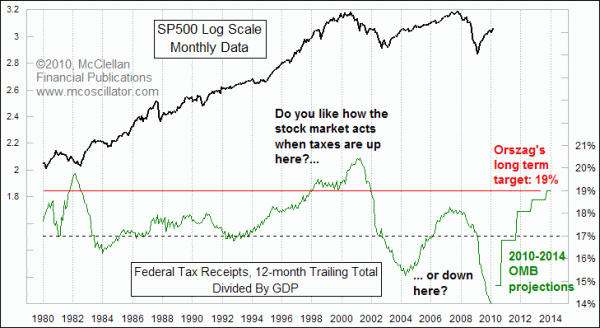Lower Tax Collections Are Bullish for Stocks

Free Chart In Focus email
Delivered to you every week
The economic slowdown in 2008 has resulted in lower tax collections for Uncle Sam. Corporations have had lower profits on which to pay taxes, and rising unemployment has lowered the taxable income of a few million taxpayers. The result is that the total federal revenues from all sources (as a percentage of GDP) have fallen to levels not seen since the early 1950s. That is bad news for the budget deficit, but really good news for investors.
This week's chart compares these total federal revenues to the behavior of the SP500. It is interesting to observe that whenever total revenues get down to below 17% of GDP, the years which follow tend to be really good ones for stock prices. Conversely, seeing federal revenues at 18% or higher tends to have a depressing effect on stock prices.
As the stock market was topping in late 2007, federal revenues had crept back up to around 18%. It was all the way up at 20.7% in early 2001, as the Internet bubble was bursting and the economy was heading into a recession. It also got up to above 19% back in 1982, which was bad for the stock market and when the unemployment rate spiked up to 10.7%.
In fact, total federal revenues have only exceeded 19% on 3 previous occasions (within the available data). Two are shown in this week's chart, 1982 and 1998-2001, and the third was just after World War II. In all three cases, a big economic slowdown resulted from having so much money taken out of the real economy and put into Uncle Sam's coffers.
High tax collections (as a percentage of GDP) is not the situation we face right now. Part of that has to do with the fact that the federal government has been doing a lot of deficit spending to try and revive the economy, so a lot more of GDP lately has been government spending. The net result is that a lot more money is staying in the economy, allowing it to be put toward the task of lifting stock prices. In every case when federal revenues drop to a very low percentage of GDP, it is bullish for stock prices in the years that follow. That is the important message for us to understand right now. There should be more to come for the stock market's uptrend because of the stimulative effects of lower taxation.
In the years to come, that condition is likely to change, if we are to believe the budget projections. For the proposed 2011 budget, Office of Management and Budget Director Peter Orszag assumes total federal receipts will climb back up to 19% by 2014. He also stated previously, when he was Director of the Congressional Budget Office, that federal revenues "would remain at 18.5 percent of GDP" throughout most of the 21st century. If these assumptions are correct, then it will help a lot to close the gap between revenues and spending. But it will also lead us to yet another bear market and economic recession, if history is any guide.
Every time federal revenues have gone above 18% of GDP, it has led to a bear market and an economic slowdown. Maybe this next time will be different. For now, though, the important point is that the current low revenues are bullish for the stock market.
Tom McClellan
Editor, The McClellan Market Report
Sep 11, 2009
Is a Higher Savings Rate a GOOD Thing? |
Nov 06, 2009
Civilian Employment Level (Follow Up) |
Nov 27, 2009
Why You Should Fear A Balanced Budget |